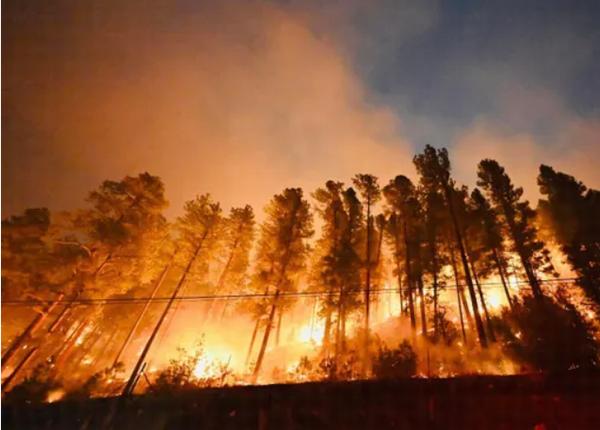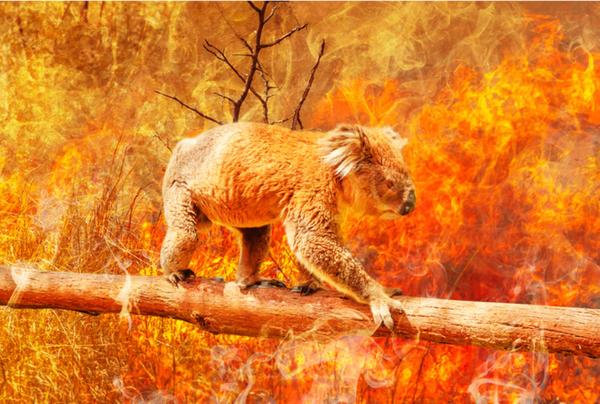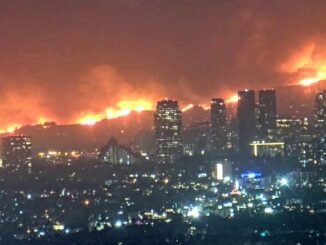
HOBART, Tasmania, Australia, June 25, 2024 (ENS) – Extreme wildfires have more than doubled in frequency and intensity over the past 21 years, according to a global study from the Fire Centre in the School of Natural Sciences at the University of Tasmania in Hobart.
Published in the journal “Nature Ecology and Evolution,” with the title, “Increasing frequency and intensity of the most extreme wildfires on Earth,” https://doi.org/10.1038/s41559-024-02452-2 the research reveals that six of the past seven years have been among the worst on record for wildfires.
Examining data from NASA’s Terra and Aqua satellites, the scientists found that the 20 most extreme wildfires selected for study each year from January 2003 to November 2023 are increasing most quickly in the boreal and temperate conifer forests of North America and Russia.
Hotspots of intense bushfires were recorded in Australia, southern Africa, Mediterranean Europe, and South America.
“The findings are alarming,” Dr. Calum Cunningham, a postdoctoral research fellow at the University of Tasmania and lead author of the study, said. “This study provides concrete evidence of a worrying trend. The intensity and frequency of these bushfires are increasing at an alarming rate, directly linked to the escalating effects of climate change.”
Using 21 years of satellite data, the research team, including Professor David Bowman and Dr. Grant Williamson, identified intense bushfire events by measuring the combined heat energy from fires each day.
The study shows that not only have the number of extreme bushfires more than doubled between 2003 and 2023, but the average intensity of the 20 most extreme bushfires each year has more than doubled during this time.

“Although the total area burned on Earth may be declining, our study highlights that fire behaviour is worsening in several regions – particularly the boreal and temperate conifer biomes – with substantial implications for carbon storage and human exposure to wildfire disasters,” the authors state in their study.
The summer of 2023 was Earth’s hottest since global records began in 1880, the U.S. National Aeronautics and Space Administration, NASA, reports in a separate study by scientists at NASA’s Goddard Institute of Space Studies in New York.
The months of June, July, and August combined were 0.23 degrees Celsius (0.41 degrees Fahrenheit) warmer than any other summer in NASA’s record, and 1.2°C (2.1°F) warmer than the average summer between 1951 and 1980.
This new record comes as exceptional heat swept across much of the world, worsening deadly wildfires in Canada and Hawaii, and searing heat waves in South America, Japan, Europe, and the United States.
“Summer 2023’s record-setting temperatures aren’t just a set of numbers – they result in dire real-world consequences,” said NASA Administrator Bill Nelson, who was not involved in the University of Tasmania’s research study.
“From sweltering temperatures in Arizona and across the country, to wildfires across Canada, and extreme flooding in Europe and Asia, extreme weather is threatening lives and livelihoods around the world. The impacts of climate change are a threat to our planet and future generations, threats that NASA and the Biden-Harris Administration are tackling head on,” Nelson said.
The study underscores the urgent need for adaptive measures to mitigate the growing threat of extreme wildfires.
“The impact of these extreme events is devastating, not only for natural ecosystems but also for human populations. These fires release significant carbon emissions, threatening to create a vicious cycle that further accelerates global warming,” Dr. Cunningham said.
“Extreme bushfires result in catastrophic ecological damage, significant carbon emissions, and severe impacts on human health and safety,” he said. “For instance, Australia’s ‘Black Summer’ bushfires of 2019-2020 were unprecedented in their scale and intensity, leading to massive ecological destruction and substantial carbon emissions.
The deadliest bushfires in Australian history were recorded during that Black Summer, July 2019 through March 2020. More than 18 million hectares (69,500 square miles) were scorched, 5.4 million hectares in the state of New South Wales alone.
Smoke from the Black Summer fires was responsible for 450 deaths, while the fires directly caused 26 fatalities as well as devastating losses for biodiversity, according to a June 2023 article in “Wood Central,” Australia’s only dedicated platform covering wood-based media.
Almost three billion koalas, kangaroos and other animals are estimated to have been killed or displaced in Australia’s ‘Black Summer’ bushfires, according to an updated study from 2020 trebling the previous estimate of one billion.
The Black Summer fires were the worst single event for wildlife in Australia, and among the worst in the world. Some species may be pushed to extinction, according to the study, funded by WWF Australia.
The Black Summer fires affected more than 300 threatened species, and hundreds of species previously considered secure.

In 2022, the Australian government listed the iconic koala bear as an endangered species on Australia’s east coast in a grim outcome of the fires that requires urgent action, according to animal welfare and conservation groups.
The listing means koala populations in Queensland, New South Wales and the Australian Capital Territory are classified as Endangered and recognizes that without stronger protections, east coast koalas are at risk of disappearing.
WWF-Australia conservation scientist Dr. Stuart Blanch said, “Koalas have gone from no-listing to vulnerable to endangered within a decade. That is a shockingly fast decline.” He called the listing decision “welcome,” but said “it won’t stop koalas from sliding towards extinction unless it’s accompanied by stronger laws and landholder incentives to protect their forest homes.”
“Unfortunately, climate change is happening. Things that we said would come to pass are coming to pass,” said Gavin Schmidt, climate scientist and director of Goddard Institute of Space Studies. “And it will get worse if we continue to emit carbon dioxide and other greenhouse gases into our atmosphere.”
With global temperatures on the rise, the conditions that lead to these extreme wildfires are expected to worsen. In view of this situation, the Tasmanian researchers are calling for robust climate action and improved bushfire management strategies.
“Immediate global action is necessary to tackle the root causes of climate change. We must also develop more effective wildfire management practices that are tailored to the specific needs of each local area,” Dr. Cunningham said. “Our findings highlight the critical need for both mitigation and adaptation strategies to protect our planet and its inhabitants.”
Featured image: A wildfire in Yakutia in Russia’s far north. 2023. (Photo courtesy Aerial Forest Protection Service, a branch of the Russian Federal Forest Service)
© 2024, Environment News Service. All rights reserved. Content may be quoted only with proper attribution and a direct link to the original article. Full reproduction is prohibited.



